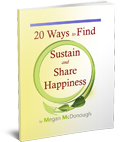Ah, the glory of the holiday season. In December families gather around warm fires and sip hot cocoa—not the instant kind you nuke with water but the old-fashioned kind you make with milk warmed on the stove. Stockings are hung with care and trees are trimmed while carols are being sung. Children’s cheeks are rosy from sledding, and good cheer fills the heart and home.
Until, of course, Mom has a meltdown over the never-ending shopping list filled with people she has no idea what to get and Dad throws the Christmas lights on the floor, unable to find the defective bulb that’s holding the whole strand hostage. Like a bad thriller movie featuring the sweet guy who turns into a demented killer, Christmas cheer transforms into holiday hell.
It’s all fun and games until someone gets poked in the eye.
Here’s my personal interpretation of the hectic life: Its job is to build constructive attention. What are you paying attention to? To hear the quiet whisper of truth in a rock-band-volume life takes great discipline and nerves of steel.
Your work demands that same steely discipline. For me, that discipline is not a display of brute force, in which I push myself to do certain tasks. Instead, it takes the form of questioning, observing, and listening. Some questions to ponder as you consider new a new direction include:
What is my mission?
What drives and motivates me to do what I do?
From where do I take my direction?
What is the source of my decision-making?
Given that, what are my priorities for the new direction?
What step-by-step process do I follow to get that done?
Who can help me with those steps? What are their specific duties?
Each year I go through a business-planning process. Sometimes I plan with a group, sometimes alone. Some years the plan is detailed and long, other times short and sweet. Sometimes I pay someone to create a plan of action, other times I do it myself.
One thing I know for sure: The form of the plan doesn’t matter in the least. What counts is the clarity, focus, and peace the planning process brings to my mind. The planning process, not the plan itself, is the gem. Through the process, I spend time questioning, considering, and listening instead of doing, implementing, and taking action.
Once you have given yourself permission to sit with the possibilities and dream about the potentials, your mind finds freedom instead of getting trapped listening to a broken record that keeps squawking about what needs to be done. The planning process develops constructive attention.
Here’s a real-life example.
When I reflected on the questions above, it was clear that more discipline was needed for my writing. So I set aside Monday mornings, and today was my first day to start. Little did I know the kids would have a snow day. Instead of quiet writing time, I have a sick son hacking away and a daughter begging me to go to the store and get more Christmas lights for the tree she wants to decorate (yes, my husband actually did toss down the string of lights in frustration—and if I am to be completely truthful, I have had a meltdown or two lately).
Despite all this, I’m writing. It is not at all like I’d planned (it never is), but I am choosing to focus my attention on this word right now. I hear my husband and daughter arguing, my son is coming over looking for attention…and I notice that I have finished this sentence.
Now I’m off to give my attention to my son, get lights for the tree, and otherwise dive into the holiday truth as it unfolds in my house.
May your holiday truth be one of peace and love, even if the occasional meltdown blows apart the fairy-tale myth of holiday perfection.



 Sign up and receive 20 Ways to Find, Sustain and Share Happiness along with ongoing tips for achieving personal and professional clarity.
Sign up and receive 20 Ways to Find, Sustain and Share Happiness along with ongoing tips for achieving personal and professional clarity.



